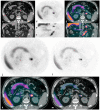Targeted Molecular Imaging in Adrenal Disease-An Emerging Role for Metomidate PET-CT
- PMID: 27869719
- PMCID: PMC5192517
- DOI: 10.3390/diagnostics6040042
Targeted Molecular Imaging in Adrenal Disease-An Emerging Role for Metomidate PET-CT
Abstract
Adrenal lesions present a significant diagnostic burden for both radiologists and endocrinologists, especially with the increasing number of adrenal 'incidentalomas' detected on modern computed tomography (CT) or magnetic resonance imaging (MRI). A key objective is the reliable distinction of benign disease from either primary adrenal malignancy (e.g., adrenocortical carcinoma or malignant forms of pheochromocytoma/paraganglioma (PPGL)) or metastases (e.g., bronchial, renal). Benign lesions may still be associated with adverse sequelae through autonomous hormone hypersecretion (e.g., primary aldosteronism, Cushing's syndrome, phaeochromocytoma). Here, identifying a causative lesion, or lateralising the disease to a single adrenal gland, is key to effective management, as unilateral adrenalectomy may offer the potential for curing conditions that are typically associated with significant excess morbidity and mortality. This review considers the evolving role of positron emission tomography (PET) imaging in addressing the limitations of traditional cross-sectional imaging and adjunctive techniques, such as venous sampling, in the management of adrenal disorders. We review the development of targeted molecular imaging to the adrenocortical enzymes CYP11B1 and CYP11B2 with different radiolabeled metomidate compounds. Particular consideration is given to iodo-metomidate PET tracers for the diagnosis and management of adrenocortical carcinoma, and the increasingly recognized utility of 11C-metomidate PET-CT in primary aldosteronism.
Keywords: adrenal; adrenocortical carcinoma; metomidate; nuclear medicine; primary aldosteronism.
Conflict of interest statement
The authors declare no conflict of interest.
Figures




Similar articles
-
Metomidate-based imaging of adrenal masses.Horm Cancer. 2011 Dec;2(6):348-53. doi: 10.1007/s12672-011-0093-3. Horm Cancer. 2011. PMID: 22124841 Free PMC article. Review.
-
11C-metomidate PET in the diagnosis of adrenal masses and primary aldosteronism: a review of the literature.Endocrine. 2020 Dec;70(3):479-487. doi: 10.1007/s12020-020-02474-3. Epub 2020 Sep 4. Endocrine. 2020. PMID: 32886316 Review.
-
Adrenal Molecular Imaging.Front Horm Res. 2016;45:70-9. doi: 10.1159/000442317. Epub 2016 Mar 15. Front Horm Res. 2016. PMID: 27003680 Review.
-
Positron emission tomography imaging of adrenal masses: (18)F-fluorodeoxyglucose and the 11beta-hydroxylase tracer (11)C-metomidate.Eur J Nucl Med Mol Imaging. 2004 Sep;31(9):1224-30. doi: 10.1007/s00259-004-1575-0. Epub 2004 Jun 10. Eur J Nucl Med Mol Imaging. 2004. PMID: 15197504 Clinical Trial.
-
Imaging of adrenal incidentalomas with PET using (11)C-metomidate and (18)F-FDG.J Nucl Med. 2004 Jun;45(6):972-9. J Nucl Med. 2004. PMID: 15181132 Clinical Trial.
Cited by
-
A comparison of the performance of 68Ga-Pentixafor PET/CT versus adrenal vein sampling for subtype diagnosis in primary aldosteronism.Front Endocrinol (Lausanne). 2024 Feb 14;15:1291775. doi: 10.3389/fendo.2024.1291775. eCollection 2024. Front Endocrinol (Lausanne). 2024. PMID: 38419957 Free PMC article.
-
68Ga-Pentixafor PET/CT for the assessment of therapeutic outcomes following superselective adrenal arterial embolization in patients with primary aldosteronism.EJNMMI Res. 2025 Jan 16;15(1):5. doi: 10.1186/s13550-024-01194-3. EJNMMI Res. 2025. PMID: 39821475 Free PMC article.
-
Large adrenal mass heralding the diagnosis of occult extra-adrenal malignancy in two patients.BMJ Case Rep. 2021 Feb 22;14(2):e239463. doi: 10.1136/bcr-2020-239463. BMJ Case Rep. 2021. PMID: 33619138 Free PMC article.
-
Key to the Treatment of Primary Aldosteronism in Secondary Hypertension: Subtype Diagnosis.Curr Hypertens Rep. 2023 Dec;25(12):471-480. doi: 10.1007/s11906-023-01269-x. Epub 2023 Oct 3. Curr Hypertens Rep. 2023. PMID: 37787864 Review.
-
2023 Korean Endocrine Society Consensus Guidelines for the Diagnosis and Management of Primary Aldosteronism.Endocrinol Metab (Seoul). 2023 Dec;38(6):597-618. doi: 10.3803/EnM.2023.1789. Epub 2023 Oct 13. Endocrinol Metab (Seoul). 2023. PMID: 37828708 Free PMC article.
References
-
- Grumbach M.M., Biller B.M., Braunstein G.D., Campbell K.K., Carney J.A., Godley P.A., Harris E.L., Lee J.K., Oertel Y.C., Posner M.C., et al. Management of the clinically inapparent adrenal mass (“incidentaloma”) Ann. Intern. Med. 2003;138:424–429. doi: 10.7326/0003-4819-138-5-200303040-00013. - DOI - PubMed
Publication types
Grants and funding
LinkOut - more resources
Full Text Sources
Other Literature Sources

